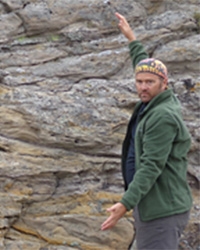High-Resolution Architecture of Proximal Basin-Floor Deepwater Clastics: Examples from Outcrop, Permian Upper Brushy Canyon Formation, West Texas
Presenter
Jesse J. Melick
Geologist, BP Americas
Abstract
Well-exposed outcrop analogs of submarine fan systems are critical to the oil and gas industry. Managing complexity in conventional and unconventional deepwater reservoirs is optimized by understanding distribution of fine-scale heterogeneity, as captured in large high-resolution outcrop studies. The 35 mile continuous outcrops along the Guadalupe and Delaware Mountains expose the 1000 foot-thick Guadalupian Brushy Canyon Formation representing slope and proximal basin-floor deposits of the Lowstand Systems Tract of one third-order clastic sequence. Three informal Brushy Canyon members record vertical and lateral changes in submarine channel architecture and depocenter position. These fourth-order basin-floor fans, sourced by canyon feeder systems and deposited below an exposed shelf margin, consist of sandstones bounded by organic-rich siltstones and record cyclicity at multiple scales. This study presents detailed field mapping of the upper Brushy Canyon member (facies, event beds and sedimentary body architecture) based on centimeter-scale measured sections correlated by continuous siltstone markers mapped on high-resolution photo panels of a 4 mile-long by 350 foot-thick outcrop segment. In this detailed window, integrated with the complete Brushy Canyon system, high-resolution stratigraphic architecture documents systematic changes in facies and sedimentary bodies at multiple scales, characterizing the temporal and spatial variation in heterogeneity. Fundamental stratigraphic trends include: 1) increase in channel depth and silty-sandstone proportion; 2) more continuous channel-base mudstone drapes; 3) increase in carbonate material (shelfal allochems and mud) and TOC from marine organic matter and; 4) landward shift in depocenter. Relative sea-level change is interpreted to be the primary driver for these trends. The terminal marine deepening that flooded the shelf at the end of this 3rd-order cycle began gradually during deposition of the upper Brushy Canyon interval. Unidirectional lithological vertical trends (increasing TOC in siltstones, carbonate allochems, silty sandstone) track the longer-term base-level rise and outbuilding of the slope, while bidirectional trends in sedimentary body attributes (type, shape, size and fill style) respond to higher-frequency cyclicity. Results from this large detailed outcrop study can be applied to structured slope and proximal basin floor reservoirs, such as GoM, Brazil and West African continental margins.
Bio
Jesse grew up in rainy but beautiful Roseburg Oregon and upon graduating high school moved to sunny Golden Colorado. There got his BS in Geological Engineering and MS in Geology both from Colorado School of Mines, working with Mike Gardner on deepwater outcrops of the Permian Brushy Canyon.
After a lengthy masters and needing some Euro-time, he did a pre-doc in Italy working with Emiliano Mutti and mapping the Eocene Ainsa Sandstones in Spain.
Upon finding his to-be wife and no work in Italy, he moved them both back to Montana State University to start a PhD in reservoir-scale basin characterization for geological CO2 sequestration funded by the DOE.
He finally graduated May 2013 after almost two years working at BP, where he supported Thunder Horse structured slope perched apron depositional model update and stratigraphic framework refresh. Since then, he has worked many of the onshore basins in the US from the Ordovician to the Miocene. He has now been working for two years on the exploration team for the Lower 48 Onshore business specializing in under the gun reservoir characterization.
